Polytetrafluoroethylene
Polytetrafluoroethylene(PTFE) is a syntheticfluoropolymeroftetrafluoroethylene,and has numerous applications because it is chemically inert. The commonly known brand name of PTFE-based composition isTeflonbyChemours,[1]aspin-offfromDuPont,which originally discovered the compound in 1938.[1]

| |

| |
| Names | |
|---|---|
| IUPAC name
Poly(1,1,2,2-tetrafluoroethylene)[2]
| |
| Other names
Fluon, Poly(tetrafluoroethene), Poly(difluoromethylene), Poly(tetrafluoroethylene), teflon
| |
| Identifiers | |
| Abbreviations | PTFE |
| ChEBI | |
| ChemSpider |
|
| ECHA InfoCard | 100.120.367 |
| KEGG | |
| UNII | |
CompTox Dashboard(EPA)
|
|
| Properties | |
| (C2F4)n | |
| Density | 2200kg/m3 |
| Melting point | 327°C |
| Electrical resistivity | 1018Ω·cm[a] |
| Thermal conductivity | 0.25 W/(m·K) |
| Hazards | |
| NFPA 704(fire diamond) | |
Except where otherwise noted, data are given for materials in theirstandard state(at 25 °C [77 °F], 100 kPa).
| |
Polytetrafluoroethylene is afluorocarbonsolid, as it is a high-molecular-weightpolymer consisting wholly ofcarbonandfluorine.PTFE ishydrophobic:neither water nor water-containing substanceswetPTFE, as fluorocarbons exhibit only smallLondon dispersion forcesdue to the lowelectric polarizabilityof fluorine. PTFE has one of the lowest coefficients offrictionof any solid.
Polytetrafluoroethylene is used as anon-stick coatingfor pans and other cookware. It is non-reactive, partly because of the strength ofcarbon–fluorine bonds,so it is often used in containers and pipework for reactive and corrosive chemicals. Where used as alubricant,PTFE reduces friction, wear, and energy consumption of machinery. It is used as a graft material in surgery and as a coating oncatheters.
PTFE and chemicals used in its production are some of the best-known and widely applied[citation needed]PFAS,which arepersistent organic pollutants.For decades, DuPont usedperfluorooctanoic acid(PFOA, or C8) during production of PTFE, later discontinuing its use due tolegal actionsover ecotoxicological and health issues. Dupont's spin-off Chemours today manufactures PTFE using an alternative chemical it callsGenX,another PFAS.
History
[edit]
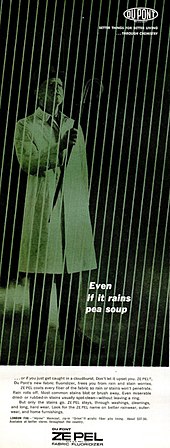
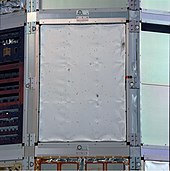

Polytetrafluoroethylene (PTFE) was accidentally discovered in 1938 byRoy J. Plunkettwhile he was working in Chemours Chambers Works plant in New Jersey forDuPont.A team of Dupont chemists attempted to make a newchlorofluorocarbonrefrigerant, calledtetrafluoroethylene.The gas in its pressure bottle stopped flowing before the bottle's weight had dropped to the point signaling "empty". John J. Beall (chemist), noticing a weight differential in his test cylinder, brought it to the attention of Roy Plunkett. The chemists in the lab sawed the bottle apart and found the bottle's interior coated with a waxy white material that was oddly slippery. Analysis showed that it was polymerized perfluoroethylene, with the iron from the inside of the container having acted as a catalyst at high pressure.[4]Kinetic Chemicals patented the new fluorinated plastic (analogous to the already knownpolyethylene) in 1941,[5]and registered the Teflon trademark in 1945.[6][7]
By 1948, DuPont, which founded Kinetic Chemicals in partnership withGeneral Motors,was producing over 910,000 kilograms (2,000,000 lb) of Teflon-brand polytetrafluoroethylene per year inParkersburg, West Virginia.[8]An early use was in theManhattan Projectas a material to coat valves and seals in the pipes holding highly reactiveuranium hexafluorideat the vastK-25uranium enrichmentplant inOak Ridge, Tennessee.[9]
In 1954, Colette Grégoire urged her husband, the French engineer Marc Grégoire, to try the material he had been using on fishing tackle on her cooking pans. He subsequently created the first PTFE-coated,non-stick pansunder the brand nameTefal(combining "Tef" from "Teflon" and "al" from aluminium).[10]In the United States,Marion A. Trozzolo,who had been using the substance on scientific utensils, marketed the first US-made PTFE-coated pan, "The Happy Pan", in 1961.[11]Non-stick cookware has since become a common household product, now offered by hundreds of manufacturers across the world.
The brand name Zepel was used for promoting its stain-resistance and water-resistance when applied to fabrics.[12]
In the 1990s, it was found that PTFE could be radiationcross-linkedabove its melting point in an oxygen-free environment.[13]Electron beam processingis one example of radiation processing. Cross-linked PTFE has improved high-temperature mechanical properties and radiation stability. That was significant because, for many years, irradiation at ambient conditions has been used to break down PTFE for recycling.[14]This radiation-inducedchain scissionallows it to be more easily reground and reused.
Corona discharge treatmentof the surface to increase the energy and improve adhesion has been reported.[15]
Production
[edit]PTFE is produced byfree-radicalpolymerizationoftetrafluoroethylene.[16]The net equation is
- nF2C=CF2→ −(F2C−CF2)n−
Because tetrafluoroethylene can explosively decompose totetrafluoromethane() and carbon, a special apparatus is required for the polymerization to prevent hot spots that might initiate this dangerous side reaction. The process is typically initiated withpersulfate,whichhomolyzesto generate sulfate radicals:
- [O3SO−OSO3]2−⇌ 2SO•−
4
The resulting polymer is terminated withsulfate estergroups, which can behydrolyzedto give OHend-groups.[17]
Granular PTFE is produced via suspension polymerization, where PTFE is suspended in an aqueous medium primarily via agitation and sometimes with the use of a surfactant. PTFE is also synthesized via emulsion polymerization, where a surfactant is the primary means of keeping PTFE in an aqueous medium.[18]Surfactants in the past have included toxicperfluorooctanoic acid(PFOA) andperfluorooctanesulfonic acid(PFOS). More recently, Perfluoro 3,6 dioxaoctanoic acid (PFO2OA) andFRD-903(GenX) are being used as alternative surfactants.[19]
Properties
[edit]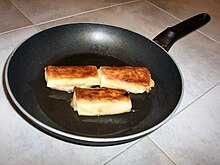
PTFE is athermoplasticpolymer,which is a white solid at room temperature, with a density of about 2200 kg/m3and a melting point of 600 K (327 °C; 620 °F).[20]It maintains high strength, toughness and self-lubrication at low temperatures down to 5 K (−268.2 °C; −450.7 °F), and good flexibility at temperatures above 194 K (−79.15 °C; −110.5 °F).[21]PTFE gains its properties from the aggregate effect ofcarbon-fluorine bonds,as do all fluorocarbons. The only chemicals known to affect these carbon-fluorine bonds are highly reactive metals like thealkali metals,at higher temperatures such metals as aluminium and magnesium, and fluorinating agents such asxenon difluorideandcobalt(III) fluoride.[22]At temperatures above 650–700 °C (1,200–1,290 °F) PTFE undergoes depolymerization.[23]However, it begins to decompose at about 260 °C (500 °F) through 350 °C (662 °F), andpyrolysisoccurs at temperatures above 400 °C (752 °F).[24]
| Property | Value |
|---|---|
| Glass temperature | 114.85 °C (238.73 °F; 388.00 K)[25] |
| Thermal expansion | 112–125×10−6K−1[26] |
| Thermal diffusivity | 0.124 mm2/s[27] |
| Young's modulus | 0.5 GPa |
| Yield strength | 23 MPa |
| Coefficient of friction | 0.05–0.10 |
| Dielectric constant | ε = 2.1,tan(δ)< 5×10−2 |
| Dielectric constant (60 Hz) | ε = 2.1,tan(δ)< 2×10−2 |
| Dielectric strength(1 MHz) | 60 MV/m |
| Magnetic susceptibility(SI, 22 °C) | −10.28×10−6[28] |
Thecoefficient of frictionof plastics is usually measured against polished steel.[29]PTFE's coefficient of friction is 0.05 to 0.10,[20]which is the third-lowest of any known solid material (aluminium magnesium boride(BAM) being the first, with a coefficient of friction of 0.02;diamond-like carbonbeing second-lowest at 0.05). PTFE's resistance tovan der Waals forcesmeans that it is the only known surface to which ageckocannot stick.[30]In addition, PTFE can be used to prevent insects from climbing up surfaces painted with the material. For example, PTFE is used to prevent ants from climbing out offormicaria.There aresurface treatments for PTFEthat alter the surface to allow adhesion to other materials.
Because of its chemical and thermal properties, PTFE is often used as a gasket material within industries that require resistance to aggressive chemicals such as pharmaceuticals or chemical processing.[31]However, until the 1990s,[13]PTFE was not known to crosslink like anelastomer,due to its chemical inertness. Therefore, it has no "memory" and is subject tocreep.Because of the propensity to creep, the long-term performance of such seals is worse than for elastomers that exhibit zero, or near-zero, levels of creep. In critical applications,Belleville washersare often used to apply continuous force to PTFE gaskets, thereby ensuring a minimal loss of performance over the lifetime of the gasket.[32]
PTFE is anultraviolet(UV) transparent polymer. However, when exposed to anexcimer laserbeam it severely degrades due to heterogeneousphotothermal effect.[33]
Processing
[edit]Processing PTFE can be difficult and expensive, because the high melting temperature, 327 °C (621 °F), is above the decomposition temperature. Even when molten, PTFE does not flow due to its exceedingly high melt-viscosity.[34][35]The viscosity and melting point can be decreased by inclusion of small amount ofcomonomerssuch as perfluoro (propylvinyl ether) andhexafluoropropylene(HFP). These cause the otherwise perfectly linear PTFE chain to become branched, reducing its crystallinity.[36]
Some PTFE parts are made by cold-moulding, a form ofcompression molding.[37]Here, fine powdered PTFE is forced into a mould under high pressure (10–100 MPa).[37]After a settling period, lasting from minutes to days, the mould is heated at 360 to 380 °C (680 to 716 °F),[37]allowing the fine particles to fuse (sinter) into a single mass.[38]
Applications and uses
[edit]This sectionneeds additional citations forverification.(May 2017) |
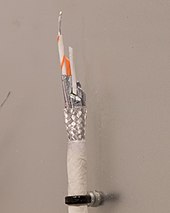
Wire insulation, electronics
[edit]The major application of PTFE, consuming about 50% of production,[39]is for the insulation of wiring in aerospace and computer applications (e.g. hookup wire, coaxial cables).[40][39]This application exploits the fact that PTFE has excellentdielectricproperties, specifically lowgroup velocity dispersion,[41]especially at highradio frequencies,[41]making it suitable for use as an excellentinsulatorinconnectorassemblies andcables,and inprinted circuit boardsused atmicrowavefrequencies. Combined with its high melting temperature, this makes it the material of choice as a high-performance substitute for the weaker, higher dispersion and lower-melting-pointpolyethylenecommonly used in low-cost applications.
Bearings seals
[edit]In industrial applications, owing to its low friction, PTFE is used forplain bearings,gears,slide plates,seals, gaskets, bushings,[42]and more applications with sliding action of parts, where it outperformsacetalandnylon.[43]
Electrets
[edit]Its extremely high bulkresistivitymakes it an ideal material for fabricating long-lifeelectrets,theelectrostaticanalogues ofpermanent magnets.
Composites
[edit]PTFE film is also widely used in the production of carbon fiber composites as well as fiberglass composites, notably in the aerospace industry. PTFE film is used as a barrier between the carbon or fiberglass part being built, and breather and bagging materials used to incapsulate the bondment when debulking (vacuum removal of air from between layers of laid-up plies of material) and when curing the composite, usually in an autoclave. The PTFE, used here as a film, prevents the non-production materials from sticking to the part being built, which is sticky due to the carbon-graphite or fiberglass plies being pre-pregnated withbismaleimideresin. Non-production materials such as Teflon, Airweave Breather and the bag itself would be considered F.O.D. (foreign object debris/damage) if left in layup.
Gore-Texis a brand of expanded PTFE (ePTFE), a material incorporating a fluoropolymer membrane with micropores. The roof of theHubert H. Humphrey MetrodomeinMinneapolis,US, was one of the largest applications of PTFE coatings. 20 acres (81,000 m2) of the material was used in the creation of the white double-layered PTFE-coated fiberglass dome.
Chemically inert liners
[edit]Because of its extreme non-reactivity and high temperature rating, PTFE is often used as the liner inhoseassemblies,expansion joints,and in industrial pipe lines, particularly in applications using acids, alkalis, or other chemicals. Its frictionless qualities allow improved flow of highly viscous liquids, and for uses in applications such as brake hoses.
Tensioned membrane structures
[edit]PTFE architectural membranes are created by coating a woven glass-fibre base cloth with PTFE, forming one of the strongest and most durable materials used intensile structures.[44]Some notable structures featuring PTFE-tensioned membranes includeThe O2 Arenain London,Moses Mabhida Stadiumin South Africa,Metropolitano Stadiumin Spain and theSydney Football StadiumRoof in Australia.[45]
Musical instruments
[edit]PTFE is often found in musical instrument lubrication products; most commonly, valve oil.
Lubricants
[edit]PTFE is used in some aerosol lubricant sprays, including in micronized and polarized form. It is notable for its extremely low coefficient of friction, its hydrophobia (which serves to inhibit rust), and for the dry film it forms after application, which allows it to resist collecting particles that might otherwise form an abrasive paste.[46]Brands include GT85.[47]
Kitchen ware
[edit]
PTFE is best known for its use in coating non-stickfrying pansand other cookware, as it ishydrophobicand possesses fairly high heat resistance.
The sole plates of some clothes irons are coated with PTFE.[48]
Others
[edit]This section contains alist of miscellaneous information.(August 2023) |

Other niche applications include:
- It is often found inski bindingsas a non-mechanical AFD (anti-friction device)
- It can be stretched to contain small pores of varying sizes and is then placed between fabric layers to make a waterproof, breathable fabric in outdoor apparel.[49]
- It is used widely as a fabric protector to repel stains on formal school-wear, like uniform blazers.[50]
- It is frequently used as a lubricant to prevent captive insects and otherarthropodsfrom escaping.
- It is used as a coating for medical and healthcare applications formulated to provide strength and heat resistance to surgical devices and other medical equipment.[51]
- It is used as a film interface patch for sports and medical applications, featuring a pressure-sensitive adhesive backing, which is installed in strategic high friction areas of footwear, insoles,ankle-foot orthosis,and other medical devices to prevent and relieve friction-induced blisters, calluses and foot ulceration.[52]
- Expanded PTFE membranes have been used in trials to assisttrabeculectomysurgery to treat glaucoma.[53]
- Powdered PTFE is used inpyrotechnic compositionsas anoxidizerwith powdered metals such asaluminiumandmagnesium.Upon ignition, these mixtures form carbonaceoussootand the corresponding metalfluoride,and release large amounts of heat. They are used ininfrared decoy flaresand asignitersforsolid-fuel rocketpropellants.[54]Aluminium and PTFE is also used in somethermobaricfuel compositions.
- Powdered PTFE is used in a suspension with a low-viscosity, azeotropic mixture of siloxane ethers to create a lubricant for use intwisty puzzles.[55]
- In opticalradiometry,sheets of PTFE are used as measuring heads in spectroradiometers and broadband radiometers (e.g.,illuminancemeters andUVradiometers) due to PTFE's capability to diffuse a transmitting light nearly perfectly. Moreover, optical properties of PTFE stay constant over a wide range of wavelengths, from UV down to nearinfrared.In this region, the ratio of its regular transmittance to diffuse transmittance is negligibly small, so light transmitted through adiffuser(PTFE sheet) radiates likeLambert's cosine law.Thus PTFE enables cosinusoidal angular response for a detector measuring the power of optical radiation at a surface, e.g. in solarirradiancemeasurements.
- Teflon-coated bulletsare coated with PTFE to reduce wear on theriflingof firearms that uncoated projectiles would cause. PTFE itself does not give a projectile an armor-piercing property.[56]
- Its high corrosion resistance makes PTFE useful in laboratory environments, where it is used for lining containers, as a coating for magnetic stirrers, and as tubing for highly corrosive chemicals such ashydrofluoric acid,which will dissolve glass containers. It is used in containers for storingfluoroantimonic acid,asuperacid.[57]
- PTFE tubes are used in gas-gas heat exchangers in gas cleaning of waste incinerators. Unit power capacity is typically several megawatts.
- PTFE is widely used as athread seal tapein plumbing applications, largely replacing paste thread dope.
- PTFE membrane filters are among the most efficient industrial air filters. PTFE-coated filters are often used indust collection systemsto collectparticulate matterfrom air streams in applications involving high temperatures and high particulate loads such as coal-fired power plants, cement production and steel foundries.[58]
- PTFE grafts can be used to bypassstenoticarteriesin peripheral vascular disease if a suitable autologousveingraft is not available.
- Many bicycle lubricants and greases contain PTFE and are used onchainsand other moving parts subjected to frictional forces (such ashub bearings).
- PTFE is used for some types ofdental floss.
- PTFE can also be used when placingdental fillings,to isolate the contacts of the adjacent tooth so the restorative materials will not stick to the adjacent tooth.[59][60]
- PTFE sheets are used in the production ofbutane hash oildue to its non-stick properties and resistance to non-polar solvents.[61]
- PTFE, associated with a slightly textured laminate, makes the plain bearing system of aDobsonian telescope.
- PTFE is widely used as a non-stick coating for food processing equipment;[62]dough hoppers, mixing bowls, conveyor systems, rollers, and chutes. PTFE can also be reinforced where abrasion is present – for equipment processing seeded or grainy dough for example.[62]
- PTFE has been experimented with forelectroless nickel plating.
- PTFE tubing is used for Bowden tubing in3D printersbecause its low friction allows the extruder stepper motor to push filament through it more easily.
- PTFE is commonly used in aftermarket add-on mouse feet forgaming miceto reduce friction of the mouse against the mouse pad, resulting in a smoother glide.
- PTFE foils are commonly used with laserprinters everywhere, in their fuser unit, wrapped around the heater element(s) and as well on the opposite pressure roller to prevent any kind of sticking to it (neither the printed paper nor toner waste)
- PTFE is also used to make body jewellery as it's much safer to wear compared to materials like acrylic, that release toxics into the body at 26.6 °C, unlike PTFE at 650–700 °C.
- PTFE is used to make bookbinding tools for folding, scoring and separating sheets of paper. These are typically referred to as Teflon bone folders.
- PTFE is commonly used for the tip ofdesoldering pumpsdue to its high melting temperature.
Safety
[edit]While PTFE is stable at lower temperatures, it begins to deteriorate at temperatures of about 260 °C (500 °F), it decomposes above 350 °C (662 °F), andpyrolysisoccurs at temperatures above 400 °C (752 °F).[24]The main decomposition products arefluorocarbongases and asublimate,includingtetrafluoroethylene(TFE) anddifluorocarbeneradicals(RCF2).[24]
An animal study conducted in 1955 concluded that it is unlikely that these products would be generated in amounts significant to health at temperatures below 250 °C (482 °F).[63]Above those temperatures the degradation by-products can be lethal tobirds,[64]and can causeflu-like symptomsin humans (polymer fume fever),[65]although in humans those symptoms disappear within a day or two of being moved to fresh air.[66]
Most cases of polymer fume fever in humans occur due to smoking PTFE-contaminated tobacco,[66]although cases have occurred in people who haveweldednear PTFE components.[66]PTFE-coated cookware is unlikely to reach dangerous temperatures with normal use, as meat is usually fried between 204 and 232 °C (399 and 450 °F), and mostcooking oils(except refinedsafflowerandavocadooils) start tosmokebefore a temperature of 260 °C (500 °F) is reached. A 1973 study by DuPont's Haskell Laboratory found that a 4-hour exposure to the fumes emitted by PTFE cookware heated to 280 °C (536 °F) was lethal forparakeets,although that was a higher temperature than the 260 °C (500 °F) required for fumes from pyrolyzed butter to be lethal to the birds.[67]
Perfluorooctanoic acid(PFOA), a chemical formerly used in the manufacture of PTFE products such as non-stick coated cookware, can becarcinogenicfor people who are exposed to it (seeEcotoxicity).[68]Concerning levels of PFOA have been found in the blood of people who work in or live near factories where the chemical is used, and in people regularly exposed to PFOA-containing products such as someski waxesand stain-resistant fabric coatings, but non-stick cookware was not found to be a major source of exposure, as the PFOA is burned off during the manufacturing process and not present in the finished product.[66]Non-stick coated cookware has not been manufactured using PFOA since 2013,[69]and PFOA is no longer being made in the United States.[68]
Ecotoxicity
[edit]Trifluoroacetate
[edit]Sodium trifluoroacetateand the similar compoundsodium chlorodifluoroacetatecan both be generated when PTFE undergoesthermolysis,as well as producing longer chain polyfluoro- and/or polychlorofluoro- (C3-C14) carboxylic acids which may be equally persistent. These products can accumulate in evaporativewetlandsand have been found in the roots and seeds of wetland plant species, but has not been observed to have an adverse impact on plant health or germination success.[66]
PFOA
[edit]Perfluorooctanoic acid (PFOA, or C8) has been used as asurfactantin theemulsion polymerizationof PTFE, although several manufacturers have entirely discontinued its use.
PFOA persists indefinitely in the environment.[70]PFOA has been detected in the blood of many individuals of the general US population in the low and sub-parts per billionrange, and levels are higher in chemical plant employees and surrounding subpopulations. PFOA andperfluorooctanesulfonic acid(PFOS) have been estimated to be in every American person's blood stream in the parts per billion range, though those concentrations have decreased by 70% for PFOA and 84% for PFOS between 1999 and 2014, which coincides with the end of the production and phase out of PFOA and PFOS in the US.[71]The general population has been exposed to PFOA through massive dumping of C8 waste into the ocean and near theOhio RiverValley.[72][73][74]PFOA has been detected in industrial waste, stain-resistant carpets, carpet cleaning liquids,house dust,microwave popcorn bags,water, food and PTFE cookware.
As a result ofa class-action lawsuit and community settlementwithDuPont,threeepidemiologistsconducted studies on the population of Parkersburg, WV surrounding the (former DuPont) Chemours Washington Works chemical plant that was exposed to PFOA at levels greater than in the general population. The studies concluded that there was an association between PFOA exposure and six health outcomes:kidney cancer,testicular cancer,ulcerative colitis,thyroid disease,hypercholesterolemia(high cholesterol), andgestational hypertension(pregnancy-induced high blood pressure).[75]
Overall, PTFE cookware is considered a minor exposure pathway to PFOA.[76]
GenX
[edit]As a result of the lawsuits concerningthe PFOA class-action lawsuit,DuPont began to use GenX, a similarly fluorinated compound, as a replacement for perfluorooctanoic acid in the manufacture offluoropolymers,such as Teflon-brand PTFE.[77][78]However, in lab tests on rats, GenX has been shown to cause many of the same health problems as PFOA.[79][80]
The chemicals are manufactured byChemours,a corporate spin-off of DuPont, inFayetteville, North Carolina.[81]Fayetteville Works was the site where DuPont began manufacture of PFOA after the lawsuit in Parkersburg WV halted their production there. When EPA asked companies to voluntarily phase out PFOA production, it was replaced by GenX in Fayetteville Works. In June of 2017, The Wilmington Star-News broke the story[82]that GenX was found in the Cape Fear River – the drinking water supply for 500,000 people. The source of the pollution was determined to be the Fayetteville Works site, which had been run by DuPont since its founding in 1971 and then managed by DuPont spinoff, The Chemours Company, since 2015. The water utility confirmed they had no ability to filter these chemicals from the drinking water.
The North Carolina Department of Environmental Quality (NC DEQ) records[83]indicate that DuPont started release PFAS into the area beginning in 1976 with the production of Nafion, and that PFAS including GenX had been released as a byproduct of the production of Vinyl Ethers since 1980, exposing the Cape Fear Basin for decades. A small nonprofit called Cape Fear River Watch sued NC DEQ for not taking swifter and stronger action, and sued the polluter, Chemours, for violations of the Clean Water Act and the Toxic Substances Control Act. The result was a Consent Order,[84]signed February 25, 2019 by Cape Fear River Watch, NC DEQ, and Chemours.[85]The order has required Chemours to stop wastewater discharge, air emissions, groundwater discharge, sampling and filtration options to well users, and required sampling that proved there were upwards of 300 distinct PFAS compounds being released from Fayetteville Works.[86]
Similar polymers
[edit]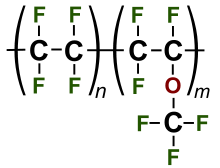
The Teflon trade name is also used for other polymers with similar compositions:
These retain the useful PTFE properties of low friction and nonreactivity, but are also more easily formable. For example, FEP is softer than PTFE and melts at 533 K (260 °C; 500 °F); it is also highly transparent and resistant to sunlight.[87]
See also
[edit]- BS 4994,PTFE as a thermoplastic lining for dual laminate chemical process plant equipment
- Dark Waters,a film about litigation related to PFOA
- The Devil We Know,documentary on PFOA's health and environmental effects
- ETFE
- Gore-Texwaterproof fabric
- Magnesium/Teflon/Viton,pyrolant thermite composition
- Polymer adsorption
- Superhydrophobic coating
- Surface treatment of PTFE
Notes
[edit]References
[edit]- ^ab"The History of Teflon Fluoropolymers".Teflon.com.Retrieved3 February2021.
- ^ "poly(tetrafluoroethylene) (CHEBI:53251)".ebi.ac.uk.Retrieved12 July2012.
- ^"PTFE".Microwaves101.Archived fromthe originalon 16 July 2014.Retrieved16 February2012.
- ^"Roy J. Plunkett".Science History Institute.June 2016.Retrieved10 February2020.
- ^US 2230654,Plunkett, Roy J,"Tetrafluoroethylene polymers", issued 4 February 1941
- ^"History Timeline 1930: The Fluorocarbon Boom".DuPont.Retrieved10 June2009.
- ^"Roy Plunkett: 1938".Archived fromthe originalon 17 February 2012.Retrieved10 June2009.
- ^American Heritage of Invention & Technology,Fall 2010, vol. 25, no. 3, p. 42
- ^Rhodes, Richard(1986).The Making of the Atomic Bomb.New York: Simon and Schuster. p. 494.ISBN0-671-65719-4.Retrieved31 October2010.
- ^"Teflon".Useless Information.home.nycap.rr.com. Archived fromthe originalon 14 February 2008.
- ^Robbins, William (21 December 1986) "Teflon Maker: Out of Frying Pan into Fame",New York Times,Retrieved 21 December 1986 (Subscription)
- ^Fenton, Lois (2 January 1992)."Go, spot, go Teflon enters fashion world as a protective coating".Baltimore Sun.Archived fromthe originalon 20 June 2021.
- ^abSun, J.Z.; et al. (1994). "Modification of polytetrafluoroethylene by radiation—1. Improvement in high temperature properties and radiation stability".Radiat. Phys. Chem.44(6): 655–679.Bibcode:1994RaPC...44..655S.doi:10.1016/0969-806X(94)90226-7.
- ^Electron Beam Processing of PTFEArchived6 September 2013 at theWayback MachineE-BEAM Services website. Accessed 21 May 2013
- ^"Corona Discharge Treatment - an overview | ScienceDirect Topics".www.sciencedirect.com.Retrieved28 April2022.
- ^Puts, Gerard J.; Crouse, Philip; Ameduri, Bruno M. (28 January 2019). "Polytetrafluoroethylene: Synthesis and Characterization of the Original Extreme Polymer".Chemical Reviews.119(3): 1763–1805.doi:10.1021/acs.chemrev.8b00458.hdl:2263/68582.PMID30689365.S2CID59338589.
- ^Carlson, D. Peter and Schmiegel, Walter (2000) "Fluoropolymers, Organic" inUllmann's Encyclopedia of Industrial Chemistry,Wiley-VCH, Weinheim.doi:10.1002/14356007.a11_393
- ^"Manufacturing Polytetrafluoroethylene".Introduction to Fluoropolymers.William Andrew. 2013. pp. 91–124.doi:10.1016/B978-1-4557-7442-5.00007-3.ISBN9781455774425.
- ^Pierozan, Paula; Cattani, Daiane; Karlsson, Oskar (February 2022)."Tumorigenic activity of alternative per- and polyfluoroalkyl substances (PFAS): Mechanistic in vitro studies".Science of the Total Environment.808:151945.Bibcode:2022ScTEn.80851945P.doi:10.1016/j.scitotenv.2021.151945.PMID34843762.S2CID244730906.
- ^ab"Fluoroplastic Comparison - Typical Properties".Chemours.Archived fromthe originalon 3 February 2016.
- ^Teflon PTFE Properties Handbook.Retrieved 11 October 2012.
- ^"Chemours Teflon™ Coating Applications".plastechcoatings.com.
- ^R. J. Hunadi; K. Baum (1982). "Tetrafluoroethylene: A Convenient Laboratory Preparation".Synthesis.39(6): 454.doi:10.1055/s-1982-29830.S2CID96276938.
- ^abcSajid, Muhammad; Ilyas, Muhammad (October 2017)."PTFE-coated non-stick cookware and toxicity concerns: a perspective".Environmental Science and Pollution Research.24(30): 23436–23440.Bibcode:2017ESPR...2423436S.doi:10.1007/s11356-017-0095-y.ISSN0944-1344.PMID28913736.S2CID10437300.
- ^Nicholson, John W. (2011).The Chemistry of Polymers(4, Revised ed.). Royal Society of Chemistry. p. 50.ISBN9781849733915.
- ^"Reference Tables – Thermal Expansion Coefficients – Plastics".engineershandbook.com.Archived fromthe originalon 3 January 2012.Retrieved2 January2012.
- ^Blumm, J.; Lindemann, A.; Meyer, M.; Strasser, C. (2011). "Characterization of PTFE Using Advanced Thermal Analysis Technique".International Journal of Thermophysics.40(3–4): 311.Bibcode:2010IJT....31.1919B.doi:10.1007/s10765-008-0512-z.S2CID122020437.
- ^Wapler, M. C.; Leupold, J.; Dragonu, I.; von Elverfeldt, D.; Zaitsev, M.; Wallrabe, U. (2014). "Magnetic properties of materials for MR engineering, micro-MR and beyond".JMR.242:233–242.arXiv:1403.4760.Bibcode:2014JMagR.242..233W.doi:10.1016/j.jmr.2014.02.005.PMID24705364.S2CID11545416.
- ^Coefficient of Friction (COF) Testing of Plastics.MatWeb Material Property Data. Retrieved 1 January 2007.
- ^"Research into Gecko Adhesion",Berkeley,2007-10-14. Retrieved 8 April 2010.
- ^"PTFE Sheet".Gasket Resources Inc.Retrieved16 August2017.
- ^Davet, George P."Using Belleville Springs To Maintain Bolt Preload"(PDF).Solon Mfg. Co.Archived fromthe original(PDF)on 18 May 2014.Retrieved18 May2014.
- ^Ferry, Laurent; Gérard, Vigier; Bessede, Jean Luc (June 1996)."Effect of ultraviolet radiation on polytetrafluoroethylene: Morphology influence".Polymers for Advanced Technologies.7(5–6): 493–500.doi:10.1002/(SICI)1099-1581(199605)7:5/6<493::AID-PAT536>3.0.CO;2-D– via Wiley.
- ^"Cowie Technology – PTFE: High Thermal Stability".Cowie.com.Retrieved16 August2017.
- ^"Free Flow Granular PTFE"(PDF).Inoflon Fluoropolymers.16 August 2017.
- ^Sina Ebnesajjad (21 September 2016).Expanded PTFE Applications Handbook: Technology, Manufacturing and Applications.William Andrew. pp. 31–32.ISBN978-1-4377-7856-4.
- ^abc"Polyflon PTFE Molding Powder"(PDF).Daikin Chemical.16 August 2017.
- ^"Unraveling Polymers: PTFE".Poly Fouoro Ltd. 26 April 2011.Retrieved23 April2017.
- ^ab"Polytetrafluoroethylene - Introduction, Production, Applications, and FAQs".VEDANTU.Retrieved1 April2024.
- ^Sack, Harald (26 June 2022)."Roy J. Plunkett and the Discovery of Teflon | SciHi Blog".Retrieved1 April2024.
- ^abMishra, Munmaya; Yagci, Yusuf (208).Handbook of Vinyl Polymers: Radical Polymerization, Process, and Technology, Second Edition(2nd, illustrated, revised ed.). CRC Press. p. 574.ISBN978-0-8247-2595-2.Extract of page 574
- ^"Teflon Machining & Fabrication".Espemfg.com.Retrieved28 August2018.
- ^Mishra & Yagci,p 573
- ^"PTFE".MakMax Australia.
- ^"Sydney Football Stadium Roof".MakMax Australia.16 August 2022.Retrieved21 July2024.
- ^"What is MicPol?".Interflonusa.com.Archived fromthe originalon 3 October 2018.Retrieved3 October2018.
- ^"GT85 General Lubricant with PTFE - 400ml".Baysidemarine.co.uk.Retrieved5 March2022.
- ^Fers à repasser semelle teflon - Fiche pratique - Le Parisien.Pratique.leparisien.fr. Retrieved on 2016-11-17.
- ^"A Motorcyclist's Guide To Gore-Tex".Infinity Motorcycles. Archived fromthe originalon 5 July 2015.Retrieved17 January2019.
- ^"Advantages and Disadvantages of Teflon-coated Covert Cloth".The Cutter and Tailor.Archived fromthe originalon 3 July 2015.Retrieved22 May2015.
- ^"PTFE & Industrial Non-Stick Fluoropolymer Coating Services | Delta Coatings & Linings, Inc".Deltacoatingsandliningsbr.com.Retrieved5 March2022.
- ^"Film Interface Patch".American Academy of Orthotists & Prosthetists.
- ^Park, Junghyun; Rittiphairoj, Thanitsara; Wang, Xue; E, Jian-Yu; Bicket, Amanda K. (13 March 2023)."Device-modified trabeculectomy for glaucoma".The Cochrane Database of Systematic Reviews.2023(3): CD010472.doi:10.1002/14651858.CD010472.pub3.ISSN1469-493X.PMC10010250.PMID36912740.
- ^Koch, E.-C. (2002). "Metal-Fluorocarbon Pyrolants:III. Development and Application of Magnesium/Teflon/Viton".Propellants, Explosives, Pyrotechnics.27(5): 262–266.doi:10.1002/1521-4087(200211)27:5<262::AID-PREP262>3.0.CO;2-8.
- ^"Lubicle 1".TheCubicle.us.Retrieved20 May2017.
- ^"Interview with an inventor of the KTW bullet".NRAction Newsletter.4(5). May 1990.
- ^Pomeroy, Ross (24 August 2013)."The World's Strongest Acids: Like Fire and Ice".Retrieved9 April2016.
- ^"Industrial Air Permits - New Clean Air Regulations And Baghouses".Baghouse.com. 28 May 2012.
- ^Brown, DDS, Dennis E. (January 2002)."Using Plumber's Teflon Tape to Enhance Bonding Procedures".Dentistry Today.21(1): 76–8, 80–1.PMID11824121.
- ^Dunn, WJ; et al. (2004). "Polytetrafluoroethylene (PTFE) tape as a matrix in operative dentistry".Operative Dentistry.29(4): 470–2.PMID15279489.
- ^Rosenthal, Ed (21 October 2014).Beyond Buds(Revised ed.). Quick American Archives.ISBN978-1936807239.
- ^ab"Fluoropolymer PTFE coating services from Surface Technology UK".Surface Technology.Retrieved26 February2018.
- ^Zapp JA, Limperos G, Brinker KC (26 April 1955). "Toxicity of pyrolysis products of 'Teflon' tetrafluoroethylene resin".Proceedings of the American Industrial Hygiene Association Annual Meeting.
- ^"Key Safety Questions About Teflon Nonstick Coatings".DuPont. Archived fromthe originalon 2 May 2013.Retrieved28 November2014.
- ^"Key Safety Questions about the Safety of Nonstick Cookware".DuPont. Archived fromthe originalon 2 May 2013.Retrieved28 November2014.
- ^abcde"Hazardous Substances Data Bank (HSDB): 833".pubchem.ncbi.nlm.nih.gov.National Center for Biotechnology Information National Library of Medicine.Retrieved4 April2022.
- ^Griffith, Franklin D.; Stephens, Susan S.; Tayfun, Figen O. (April 1973). "Exposure of Japanese Quail and Parakeets to the Pyrolysis Products of Fry Pans Coated with Teflon® and Common Cooking Oils".American Industrial Hygiene Association Journal.34(4): 176–178.doi:10.1080/0002889738506828.PMID4723395.
- ^ab"Perfluorooctanoic Acid (PFOA), Teflon, and Related Chemicals".www.cancer.org.Retrieved4 April2022.
- ^"The truth about teflon: are non-stick pans safe?".Better Homes and Gardens.2 October 2019.Retrieved11 June2020.
- ^Emerging Contaminants Fact Sheet – Perfluorooctane Sulfonate (PFOS) and Perfluorooctanoic Acid (PFOA).National Service Center for Environmental Publications(Report).United States Environmental Protection Agency.March 2014. p. 1. 505-F-14-001.Retrieved10 February2019.
- ^"PFAs Factsheet"(PDF).Casaweb.org.Retrieved5 March2022.
- ^RIch, Nathaniel (6 January 2016)."The Lawyer Who Became Dupont's Worst Nightmare".The New York Times.Retrieved7 January2016.
- ^Blake, Mariah."Welcome to Beautiful Parkersburg, West Virginia Home to one of the most brazen, deadly corporate gambits in U.S. history".HuffPost.Retrieved31 August2015.
- ^Fellner, Carrie (16 June 2018)."Toxic Secrets: Professor 'bragged about burying bad science' on 3M chemicals".The Sydney Morning Herald.Retrieved25 June2018.
- ^Nicole, W. (2013)."PFOA and Cancer in a Highly Exposed Community: New Findings from the C8 Science Panel".Environmental Health Perspectives.121(11–12): A340.doi:10.1289/ehp.121-A340.PMC3855507.PMID24284021.
- ^Trudel D, Horowitz L, Wormuth M, Scheringer M, Cousins IT, Hungerbühler K (April 2008). "Estimating consumer exposure to PFOS and PFOA".Risk Anal.28(2): 251–69.Bibcode:2008RiskA..28..251T.doi:10.1111/j.1539-6924.2008.01017.x.PMID18419647.S2CID10777081.
- ^Beekman, M.; et al. (12 December 2016)."Evaluation of substances used in the GenX technology by Chemours, Dordrecht".National Institute for Public Health and the Environment (RIVM,The Netherlands).Retrieved23 July2017.
- ^"What is the difference between PFOA, PFOS and GenX and other replacement PFAS?".PFOA, PFOS and Other PFASs.EPA. 18 February 2018.
- ^Caverly Rae, JM; Craig, Lisa; Stone, Theodore W.; Frame, Steven R.; Buxton, L. William; Kennedy, Gerald L. (2015)."Evaluation of chronic toxicity and carcinogenicity of ammonium 2,3,3,3-tetrafluoro-2-(heptafluoropropoxy)-propanoate in Sprague–Dawley rats".Toxicology Reports.2:939–949.Bibcode:2015ToxR....2..939C.doi:10.1016/j.toxrep.2015.06.001.PMC5598527.PMID28962433.
- ^Lerner, Sharon (3 March 2016)."New Teflon Toxin Causes Cancer in Lab Animals".The Intercept.Retrieved14 December2018.
- ^"GenX Frequently Asked Questions"(PDF).GenX Investigation.Raleigh, NC: North Carolina Department of Environmental Quality (NCDEQ). 15 February 2018.
- ^"Toxin taints CFPUA drinking water".
- ^"FACT SHEET: Proposed Chemours Consent Order".21 December 2018.
- ^"Chemours Consent Order | NC DEQ".
- ^"PFAS | Cape Fear River Watch".20 September 2019.
- ^"Consent Order Compliance".
- ^FEP Detailed Properties,Parker-TexLoc, 13 April 2006. Retrieved 10 September 2006.
Further reading
[edit]- Ellis, D.A.; Mabury, S.A.; Martin, J.W.; Muir, D.C.G.; Mabury, S.A.; Martin, J.W.; Muir, D.C.G. (2001). "Thermolysis of fluoropolymers as a potential source of halogenated organic acids in the environment".Nature.412(6844): 321–324.Bibcode:2001Natur.412..321E.doi:10.1038/35085548.PMID11460160.S2CID4405763.




